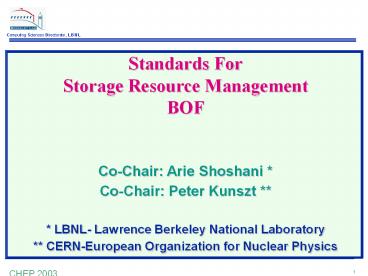Standards For - PowerPoint PPT Presentation
Title:
Standards For
Description:
Especially important for data intensive applications. Often files are archived on a mass storage system (MSS) Goals ... on a storage resource at any one time ... – PowerPoint PPT presentation
Number of Views:36
Avg rating:3.0/5.0
Title: Standards For
1
Standards For Storage Resource
Management BOF Co-Chair Arie Shoshani
Co-Chair Peter Kunszt LBNL- Lawrence
Berkeley National Laboratory CERN-European
Organization for Nuclear Physics
2
Agenda
- Introduce proposed chairs Arie Shoshani Peter
Kunszt - Focus and goals of the proposed Working Group
- Discussion of Charter in detail
- How do SRMs complement other Grid components
- Relationships to other GGF working groups
- Milestones of developing an SRM standard, and the
mechanism for its evolution over time - The value of an SRM standard in fostering
interoperation of Grid storage resource - Discuss agenda items for next meeting
3
Focus and Goalsof Proposed Working Group
- Grid architecture needs to include reservation
scheduling of - Compute resources
- Storage resources
- Network resources
- Storage Resource Managers (SRMs) role in the data
grid architecture - Shared storage resource allocation scheduling
- Especially important for data intensive
applications - Often files are archived on a mass storage system
(MSS) - Goals
- Develop a standard for Storage Resources on the
Grid - Permit interoperation of various storage systems
- Foster consensus for interoperation of multiple
institutions - Permit multiple implementations of SRMs
- Standard to be specified as a WSDL service
4
Discussion of Charter in detail
- SRM functionality
- Manage space
- Negotiate and assign space to users
- Manage lifetime of spaces
- Manage files on behalf of a user
- Pin files in storage till they are released
- Manage lifetime of files
- Manage action when pins expire (depends on file
types) - Manage file sharing
- Policies on what should reside on a storage
resource at any one time - Policies on what to evict when space is needed
- Get files from remote locations when necessary
- Purpose to simplify clients task
- Manage multi-file requests
- A brokering function queue file requests,
pre-stage when possible - Provide grid access to/from mass storage systems
- Examples HPSS (LBNL, ORNL, BNL), Enstore
(Fermi), JasMINE (Jlab), Castor (CERN), MSS
(NCAR),
5
Relationship to other Grid Components
- Interaction
- SRMs are components that Grid Planners need to
interact with - SRMs are components that Grid Executers need to
interact with - SRMs invoke Grid Transport services (e.g.
GridFTP) - SRMs interact with Monitoring Tools regarding
space usage - SRMs interact with Virtual Organization services
(e.g. CAS) - Related GGF activities
- Data Replication (REP-WG) SRM can provide
dynamic space allocation for data replication - GridFTP WG SRMs rely on an efficient transport
services - Data Access and Integration Services (DAIS-WG)
standards for accessing database management
systems
6
Milestones
- Build on existing on-going activity
- Participants LBNL, Fermilab, Jlab, EDG
- Version 1.0 implemented and proved
inter-operation - Version 2.0 in final design stages
- Expectations
- Draft requirements document December 2003
- Draft standard proposal April 2004
- Experience with some implementations August
2004 - Final standard draft December 2004
7
The value of an SRM standard in fostering
interoperation of Grid storage resource
Uniformity of Interface ? Compatibility of SRMs
Client USER/APPLICATIONS
Grid Middleware
SRM
SRM
SRM
SRM
SRM
SRM
Enstore
DCache
JASMine
CASTOR
8
Screen Dump of Demo at SC 2002
9
agenda items for next meeting
- Describe functionality document
- Space reservation
- File sharing capabilities
- Support for directory structures
- Interaction with other services (RLS, GridFTP, )
- Standard specification structure
- Prototype and testing
- Volunteer organizations
- How compatibility tests will be conducted































